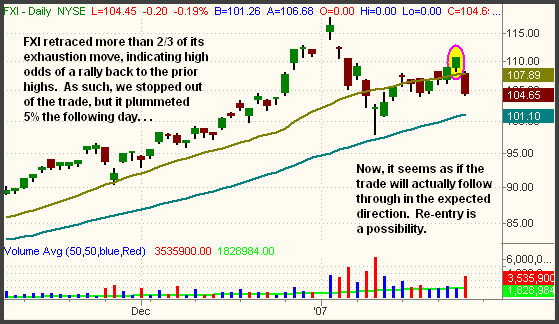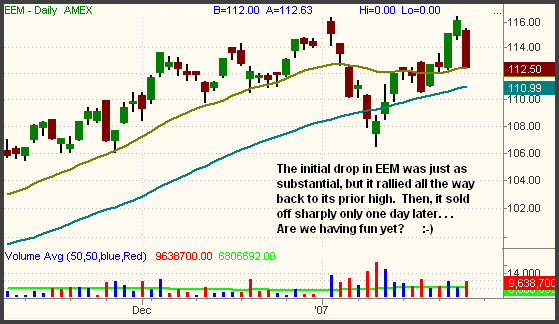| The Wagner Daily ETF Report for January 26 |
| By Deron Wagner |
Published
01/26/2007
|
Stocks
|
Unrated
|
|
|
|
The Wagner Daily ETF Report for January 26
Just when we thought it was safe to go back in the water, the fins re-appeared. Despite the prior day's fresh six-year high in the S&P 500, as well as new record highs in the Dow and S&P Midcap, the stock market was lambasted yesterday! With the exception of the Dow Jones Industrial Average, which fell "only" 0.9%, every one of the major indices shed more than 1%. The S&P 500 lost 1.1%, both the small-cap Russell 2000 and S&P Midcap 400 indices surrendered 1.2%, and the Nasdaq Composite gave up 1.3%. The tech-centered Nasdaq 100 Index plummeted 1.4%. Just as stocks trended steadily higher intraday and closed at their best levels in the previous session, they trended steadily lower and closed near their intraday lows yesterday.
Total volume in the NYSE increased by 10% yesterday, causing the S&P to register its third "distribution day" within the past four weeks. Turnover in the Nasdaq was 1% lighter than the previous day, but still came in above its 50-day average level. In both exchanges, declining volume exceeded advancing volume by a margin of 2.7 to 1.
After registering its largest daily gain of 2007 on Wednesday, the S&P 500 followed up with its largest daily loss of the new year yesterday. Such is the erratic state of the stock market lately. Since the start of the new year, forecasting the market's next move, even through sound technical analysis, has admittedly been a very challenging task. It's been several years since I personally have seen market sentiment change so frequently, in such a short period of time. Clear setups have been presenting themselves, both on the long and short side of the market, but many entries have resulted in stopping out before the trade follows through in the anticipated direction. Case in point is our recent short entries in two international ETFs, the iShares Xinhua China 25 (FXI) and the iShares Emerging Markets Index (EEM).
One week into the month of January, both ETFs had sold off sharply from parabolic moves and had broken below support of their primary uptrend lines. We subsequently waited for the proper bounce into resistance, then initiated short entries, expecting they would at least retest their lows and possibly form new lows. Given the severity of the selloff, we did not expect a bounce to more than 50% of the downward move. However, EEM rallied all the way back to its prior high, while FXI retraced more than 2/3 of its downward move. This caused us to stop out of both positions, but both ETFs collapsed yesterday, only one day after covering the FXI short position and two days after covering EEM. FXI fell 5% and EEM dropped 3%:


It is frustrating when stocks and ETFs go in the expected direction immediately after stopping out, but such action is merely a product of the environment. The only thing to do is either re-enter the position upon confirmation of the anticipated trend direction or remain on the sidelines.
Given the whipsaw market we are experiencing, what is a disciplined, professional trader or investor supposed to do? We recommend the same things discussed in yesterday's newsletter -- a minimal quantity of positions and smaller share size on all trades. Even the most astute traders are likely to sustain losses in this type of environment, so don't feel bad if you've been having a difficult time lately. However, the one thing that separates true professionals from novices is that professionals always have parameters in place to limit their losses when the going gets rough. If you're sitting on losing positions, don't be stubborn and fall into "hope" mode. Negligible losses can easily be recovered in a short period of time, but substantial losses cannot be. Trading conditions will eventually improve, making it easier to profit once again, but that won't do you any good if your trading capital has dwindled away. Capital preservation is your top priority right now!
Deron Wagner is the Founder and Head Trader of both Morpheus Capital LP, a U.S. hedge fund, and Morpheus Trading Group, a trader education firm launched in 2001 that provides daily technical analysis of the leading ETFs and stocks. For a free trial to the full version of The Wagner Daily or to learn about Wagner's other services, visit MorpheusTrading.com or send an e-mail to deron@morpheustrading.com.
|